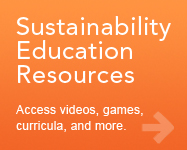Building a Park Out of Waste
 icon above to watch in full-screen mode.
icon above to watch in full-screen mode.To download video, go to Vimeo and login.
Key Facts:
Traditional ways of constructing buildings create pollution and waste. Building materials contain vast amounts of embedded energy. According to Architecture 2030, building construction and materials account for 5.5 percent of global greenhouse gas emissions. In addition, while exact numbers aren’t available, trucks and cranes transporting and installing materials at construction sites produce considerable amounts of greenhouse gas emissions.
(Source: Architecture 2030)
Typically, materials from torn-down buildings and sites are carted off to the landfill. The U.S. Environmental Protection Agency says only 40 percent of building and construction material is now “recycled, reused, or sent to waste-to-energy facilities, while the remaining 60 percent of the materials is sent to landfills.” Many sustainable architects, landscape architects, and construction firms are now moving towards a more sustainable construction process to reduce waste and greenhouse gas emissions. (Source: Environmental Protection Agency)
In a sustainable reconstruction, building materials are reused or recycled, dramatically reducing waste. For example, a new park can be created out of old building materials. Once the materials have been separated, some are kept at the construction site and reprocessed. Reclaimed soils, concrete rubble, glass, wood, and steel can be reused or recycled to serve new functions, reducing greenhouse gas emissions in the process. With climate change, any new construction methods that help landscape architects avoid producing additional emissions are a major benefit both to the project and society as a whole. In a sustainable landscape, everything old is made new again. (Source: Reuse Alliance)
This animation is designed to be a basic introduction to sustainable design concepts, created for the general public and students of all ages. We look forward to receiving your comments.
All Animations
- Designing For Active Living
- Designing Neighborhoods for People and Wildlife
- The Edible City
- Energy Efficient Home Landscapes
- From Industrial Wasteland to Community Park
- Infrastructure for All
- Leveraging the Landscape to Manage Water
- Revitalizing Communities with Parks
- Urban Forests = Cleaner, Cooler Air

 This Web site has been made possible through a grant by:
This Web site has been made possible through a grant by: